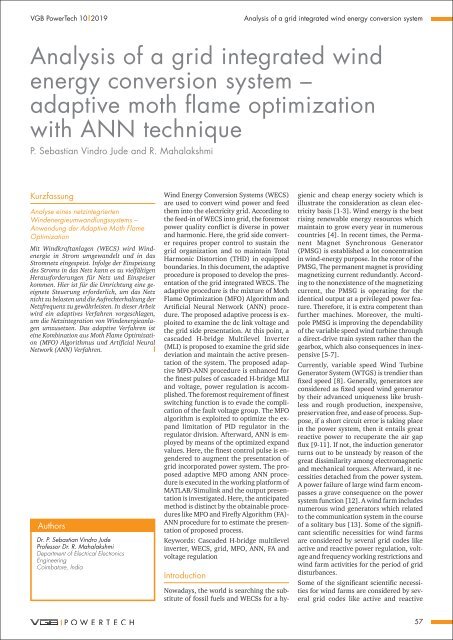VGB POWERTECH 10 (2019)
VGB PowerTech - International Journal for Generation and Storage of Electricity and Heat. Issue 10 (2019). Technical Journal of the VGB PowerTech Association. Energy is us! Cyber security. Power generation. Environment. Flexibility.
VGB PowerTech - International Journal for Generation and Storage of Electricity and Heat. Issue 10 (2019).
Technical Journal of the VGB PowerTech Association. Energy is us!
Cyber security. Power generation. Environment. Flexibility.
Sie wollen auch ein ePaper? Erhöhen Sie die Reichweite Ihrer Titel.
YUMPU macht aus Druck-PDFs automatisch weboptimierte ePaper, die Google liebt.
<strong>VGB</strong> PowerTech <strong>10</strong> l <strong>2019</strong><br />
Analysis of a grid integrated wind energy conversion system<br />
Analysis of a grid integrated wind<br />
energy conversion system –<br />
adaptive moth flame optimization<br />
with ANN technique<br />
P. Sebastian Vindro Jude and R. Mahalakshmi<br />
Kurzfassung<br />
Analyse eines netzintegrierten<br />
Windenergieumwandlungssystems –<br />
Anwendung der Adaptive Moth Flame<br />
Optimization<br />
Mit Windkraftanlagen (WECS) wird Windenergie<br />
in Strom umgewandelt und in das<br />
Stromnetz eingespeist. Infolge der Einspeisung<br />
des Stroms in das Netz kann es zu vielfältigen<br />
Herausforderungen für Netz und Einspeiser<br />
kommen. Hier ist für die Umrichtung eine geeignete<br />
Steuerung erforderlich, um das Netz<br />
nicht zu belasten und die Aufrechterhaltung der<br />
Netzfrequenz zu gewährleisten. In dieser Arbeit<br />
wird ein adaptives Verfahren vorgeschlagen,<br />
um die Netzintegration von Windenergieanlagen<br />
umzusetzen. Das adaptive Verfahren ist<br />
eine Kombination aus Moth Flame Optimization<br />
(MFO) Algorithmus und Artificial Neural<br />
Network (ANN) Verfahren. <br />
l<br />
Authors<br />
Dr. P. Sebastian Vindro Jude<br />
Professor Dr. R. Mahalakshmi<br />
Department of Electrical Electronics<br />
Engineering<br />
Coimbatore, India<br />
Wind Energy Conversion Systems (WECS)<br />
are used to convert wind power and feed<br />
them into the electricity grid. According to<br />
the feed-in of WECS into grid, the foremost<br />
power quality conflict is diverse in power<br />
and harmonic. Here, the grid side converter<br />
requires proper control to sustain the<br />
grid organization and to maintain Total<br />
Harmonic Distortion (THD) in equipped<br />
boundaries. In this document, the adaptive<br />
procedure is proposed to develop the presentation<br />
of the grid integrated WECS. The<br />
adaptive procedure is the mixture of Moth<br />
Flame Optimization (MFO) Algorithm and<br />
Artificial Neural Network (ANN) procedure.<br />
The proposed adaptive process is exploited<br />
to examine the dc link voltage and<br />
the grid side presentation. At this point, a<br />
cascaded H-bridge Multilevel Inverter<br />
(MLI) is proposed to examine the grid side<br />
deviation and maintain the active presentation<br />
of the system. The proposed adaptive<br />
MFO-ANN procedure is enhanced for<br />
the finest pulses of cascaded H-bridge MLI<br />
and voltage, power regulation is accomplished.<br />
The foremost requirement of finest<br />
switching function is to evade the complication<br />
of the fault voltage group. The MFO<br />
algorithm is exploited to optimize the expand<br />
limitation of PID regulator in the<br />
regulator division. Afterward, ANN is employed<br />
by means of the optimized expand<br />
values. Here, the finest control pulse is engendered<br />
to augment the presentation of<br />
grid incorporated power system. The proposed<br />
adaptive MFO among ANN procedure<br />
is executed in the working platform of<br />
MATLAB/Simulink and the output presentation<br />
is investigated. Here, the anticipated<br />
method is distinct by the obtainable procedures<br />
like MFO and Firefly Algorithm (FA)-<br />
ANN procedure for to estimate the presentation<br />
of proposed process.<br />
Keywords: Cascaded H-bridge multilevel<br />
inverter, WECS, grid, MFO, ANN, FA and<br />
voltage regulation<br />
Introduction<br />
Nowadays, the world is searching the substitute<br />
of fossil fuels and WECSs for a hygienic<br />
and cheap energy society which is<br />
illustrate the consideration as clean electricity<br />
basis [1-3]. Wind energy is the best<br />
rising renewable energy resources which<br />
maintain to grow every year in numerous<br />
countries [4]. In recent times, the Permanent<br />
Magnet Synchronous Generator<br />
(PMSG) is established a lot concentration<br />
in wind-energy purpose. In the rotor of the<br />
PMSG, The permanent magnet is providing<br />
magnetizing current redundantly. According<br />
to the nonexistence of the magnetizing<br />
current, the PMSG is operating for the<br />
identical output at a privileged power feature.<br />
Therefore, it is extra competent than<br />
further machines. Moreover, the multipole<br />
PMSG is improving the dependability<br />
of the variable speed wind turbine through<br />
a direct-drive train system rather than the<br />
gearbox, which also consequences in inexpensive<br />
[5-7].<br />
Currently, variable speed Wind Turbine<br />
Generator System (WTGS) is trendier than<br />
fixed speed [8]. Generally, generators are<br />
considered as fixed speed wind generator<br />
by their advanced uniqueness like brushless<br />
and rough production, inexpensive,<br />
preservation free, and ease of process. Suppose,<br />
if a short circuit error is taking place<br />
in the power system, then it entails great<br />
reactive power to recuperate the air gap<br />
flux [9-11]. If not, the induction generator<br />
turns out to be unsteady by reason of the<br />
great dissimilarity among electromagnetic<br />
and mechanical torques. Afterward, it necessities<br />
detached from the power system.<br />
A power failure of large wind farm encompasses<br />
a grave consequence on the power<br />
system function [12]. A wind farm includes<br />
numerous wind generators which related<br />
to the communication system in the course<br />
of a solitary bus [13]. Some of the significant<br />
scientific necessities for wind farms<br />
are considered by several grid codes like<br />
active and reactive power regulation, voltage<br />
and frequency working restrictions and<br />
wind farm activities for the period of grid<br />
disturbances.<br />
Some of the significant scientific necessities<br />
for wind farms are considered by several<br />
grid codes like active and reactive<br />
57


















